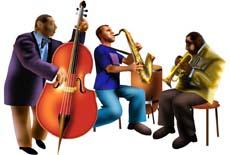Jazz Appreciation Month
Published 12:00 am Saturday, April 9, 2011
Jazz is a musical tradition and style of music that originated at the beginning of the 20th century in African American communities in the Southern United States from a confluence of African and European music traditions. From its early development until the present, jazz has incorporated music from 19th and 20th century American popular music. Its West African pedigree is evident in its use of blue notes, improvisation, polyrhythms, syncopation and the swung note.
The word “jazz” (in early years also spelled “jass”) began as a West Coast slang term and was first used to refer to music in Chicago in about 1915.
From its beginnings in the early 20th century, jazz has spawned a variety of subgenres: New Orleans Dixieland dating from the early 1910s; big band-style swing from the 1930s and 1940s; bebop from the mid-1940s; a variety of Latin jazz fusions such as Afro-Cuban and Brazilian jazz, free jazz from the 1950s and 1960s; jazz fusion from the 1970s; acid jazz from the 1980s (which added funk and hip-hop influences); and Nujazz in the 1990s. As the music has spread around the world it has drawn on local, national and regional musical cultures, its aesthetics being adapted to its varied environments and giving rise to many distinctive styles.
Origins
By 1808 the Atlantic slave trade had brought almost half a million Africans to the United States. The slaves largely came from West Africa and brought strong tribal musical traditions with them. Lavish festivals featuring African dances to drums were organized on Sundays at Place Congo, or Congo Square, in New Orleans until 1843, as were similar gatherings in New England and New York. African music was largely functional, for work or ritual, and included work songs and field hollers. The African tradition made use of a single-line melody and call-and-response pattern but without the European concept of harmony. Rhythms reflected African speech patterns, and the African use of pentatonic scales led to blue notes in blues and jazz.
In the early 19th century an increasing number of black musicians learned to play European instruments, particularly the violin, which they used to parody European dance music in their own cakewalk dances. In turn, European-American minstrel show performers in blackface popularized such music internationally, combining syncopation with European harmonic accompaniment. Louis Moreau Gottschalk adapted African-American cakewalk music, South American, Caribbean and other slave melodies as piano salon music. Another influence came from black slaves who had learned the harmonic style of hymns and incorporated it into their own music as spirituals. The origins of the blues are undocumented, though they can be seen as the secular counterpart of the spirituals.
New Orleans music
The music of New Orleans had a profound effect on the creation of early jazz. Many early jazz performers played in venues throughout the city; the brothels and bars of the red-light district around Basin Street, called “Storyville,” was only one of numerous neighborhoods relevant to the early days of New Orleans jazz. In addition to dance bands, numerous marching bands played at lavish funerals arranged by the African-American and European-American community. The instruments used in marching bands and dance bands became the basic instruments of jazz: brass and reeds tuned in the European 12-tone scale and drums. Small bands mixing self-taught and well-educated African-American musicians, many of whom came from the funeral-procession tradition of New Orleans, played a seminal role in the development and dissemination of early jazz, traveling throughout black communities in the deep south and, from around 1914 on, Afro-Creole and African American musicians playing in vaudeville shows took jazz to western and northern US cities.
The cornetist Buddy Bolden led a band often mentioned as one of the prime movers of the style later to be called “jazz.” He played in New Orleans around 1895–1906. No recordings remain of Bolden. Several tunes from the Bolden band repertory, including “Buddy Bolden Blues,” have been recorded by many other musicians. (Bolden became mentally ill and spent his later decades in a mental institution.)
Afro-Creole pianist Jelly Roll Morton began his career in Storyville. From 1904, he toured with vaudeville shows around southern cities, also playing in Chicago and New York. His “Jelly Roll Blues,” which he composed around 1905, was published in 1915 as the first jazz arrangement in print, introducing more musicians to the New Orleans style. In the northeastern United States, a “hot” style of playing ragtime had developed, notably James Reese Europe’s symphonic Clef Club orchestra in New York which played a benefit concert at Carnegie Hall in 1912. The Baltimore rag style of Eubie Blake influenced James P. Johnson’s development of “Stride” piano playing, in which the right hand plays the melody, while the left hand provides the rhythm and bassline.
The Original Dixieland Jass Band made the music’s first recordings early in 1917, and their “Livery Stable Blues” became the earliest released jazz record. That year numerous other bands made recordings featuring “jazz” in the title or band name, mostly ragtime or novelty records rather than jazz. In September 1917 W.C. Handy’s Orchestra of Memphis recorded a cover version of “Livery Stable Blues.” In February 1918 James Reese Europe’s “Hellfighters” infantry band took ragtime to Europe during World War I, then on return recorded Dixieland standards including “Darktown Strutters’ Ball.”
Want to hear it in person? French Quarter Fest is this weekend and Jazz Fest kicks off April 29.





